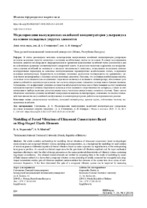| dc.contributor.author | Степаненко, Д. А. | |
| dc.contributor.author | Киндрук, А. Н. | |
| dc.coverage.spatial | Минск | ru |
| dc.date.accessioned | 2025-07-09T06:54:40Z | |
| dc.date.available | 2025-07-09T06:54:40Z | |
| dc.date.issued | 2025 | |
| dc.identifier.citation | Степаненко, Д. А. Моделирование вынужденных колебаний концентраторов ультразвука на основе кольцевых упругих элементов = Modelling of Forced Vibrations of Ultrasound Concentrators Based on Ring-Shaped Elastic Element / Д. А. Степаненко, А. Н. Киндрук // Наука и техника. – 2025. – № 3. – С. 234-245. | ru |
| dc.identifier.uri | https://rep.bntu.by/handle/data/157727 | |
| dc.description.abstract | В статье рассмотрена методика моделирования вынужденных колебаний концентраторов ультразвука на основе кольцевых упругих элементов и составных колебательных систем на их основе. В основу моделирования положено решение неоднородного дифференциального уравнения вынужденных колебаний путем разложения в ряд по собственным функциям соответствующей однородной задачи. В результате получены выражения для коэффициента усиления колебаний по амплитуде и входного механического импеданса, позволяющие исследовать влияние конструктивных параметров на основные эксплуатационные характеристики колебательных систем, содержащих кольцевые концентраторы. Корректность полученных численных результатов подтверждается их сравнением с результатами моделирования с помощью метода конечных элементов. Показано, что составная колебательная система, состоящая из последовательно соединенных стержневого волновода и кольцевого концентратора, обеспечивает усиление колебаний по амплитуде при условии, что частоты антирезонанса элементов системы имеют близкие значения. Установлено, что коэффициент усиления составной колебательной системы может быть повышен за счет увеличения площади поперечного сечения стержневого волновода и/или волнового сопротивления его материала, а также за счет оптимального выбора величины рассогласования между частотами антирезонанса элементов системы. Также дается объяснение механизма усиления колебаний однородным кольцевым концентратором, основанное на анализе взаимодействия множества мод колебаний, возбуждаемых в концентраторе при его работе в околорезонансном режиме. | ru |
| dc.language.iso | ru | ru |
| dc.publisher | БНТУ | ru |
| dc.title | Моделирование вынужденных колебаний концентраторов ультразвука на основе кольцевых упругих элементов | ru |
| dc.title.alternative | Modelling of Forced Vibrations of Ultrasound Concentrators Based on Ring-Shaped Elastic Element | ru |
| dc.type | Article | ru |
| dc.identifier.doi | 10.21122/2227-1031-2025-24-3-234-245 | |
| local.description.annotation | The article considers methodology for modelling forced vibrations of ultrasound concentrators based on ring-shaped elastic elements and compound vibratory systems including such concentrators. As a background for modelling we used solution of non-homogeneous differential equation of forced vibrations based on series expansion by eigenfunctions of the corresponding homogeneous problem. As a result we obtained expressions for the gain factor of vibrations amplitude and the input mechanical impedance allowing to study the effect of design parameters on the main operational characteristics of vibratory systems containing ring-shaped concentrators. The obtained numerical results are verified by comparing them to the results of modelling by means of finite element method. It is shown that a compound vibratory system consisting of serially connected bar waveguide and a ring-shaped concentrator enables gain of vibrations amplitude under condition that elements of the system have close values of anti-resonance frequencies. It has been determined that gain of a compound vibratory system can be improved by increasing. Crossectional area of the bar waveguide and/or specific acoustic impedance of its material, as well as by means of optimal choice of mismatch value between anti-resonant frequencies of the system elements. An explanation is also given of the mechanism of vibrations amplification by means of uniform ring-shaped concentrator based on an analysis of the interaction between plurality of vibration modes excited in concentrator in the case of its near-resonant operation. | ru |

